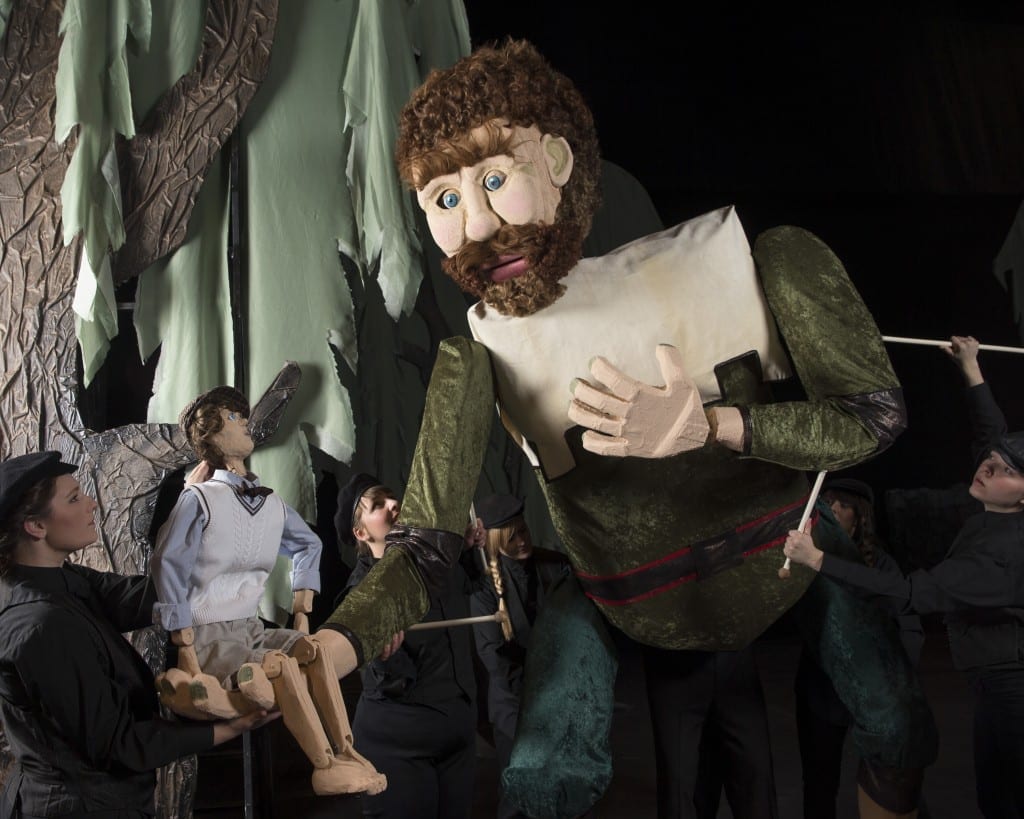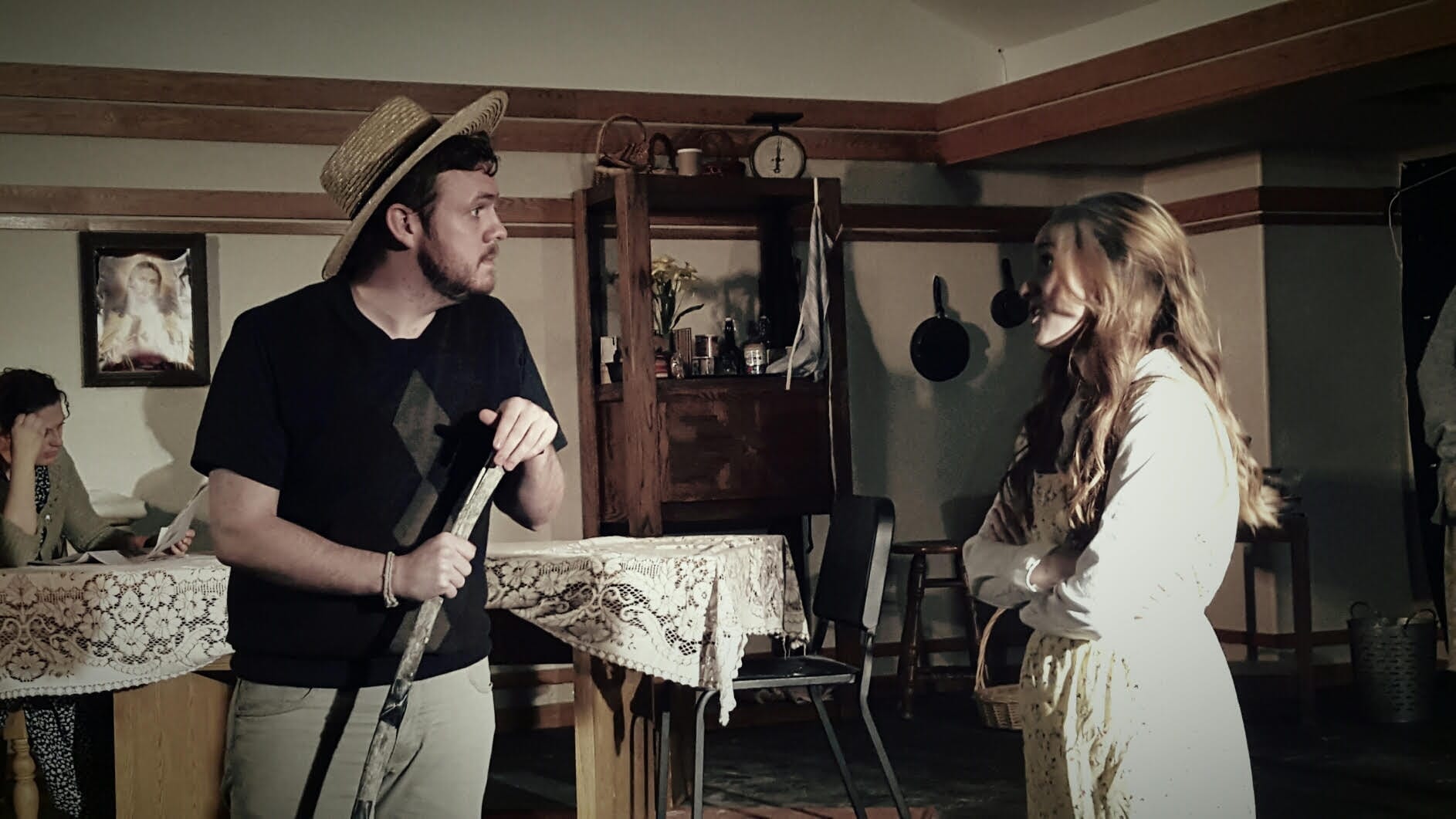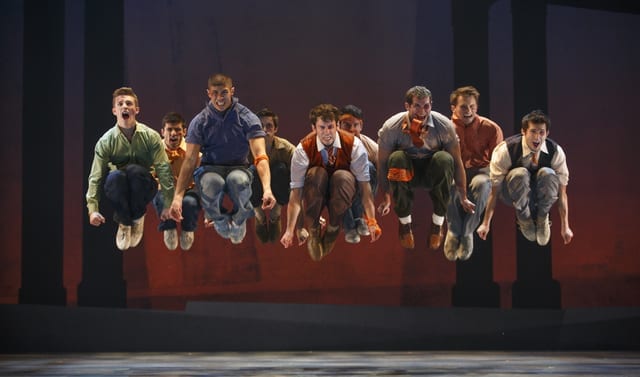PROVO — Adaptation is hard. Taking a beloved piece that works in one medium and effectively transferring it into another is a daunting task. Teresa Dayley Love‘s script for BYU’s The Selfish Giant takes Oscar Wilde‘s 1600-word short story and stretches it out into over an hour of stage time. The result, however, too often feels watered down, rather than deepened or enhanced.
The play tells the familiar story of a selfish giant who keeps his garden off limits to children, but who finds that springtime is unable to enter his domain until he softens his heart and allows the children back in. Here, the story is narrated by the Cornish ogre (Reese Purser). While he gets nothing more than a cursory mention in Wilde’s story, the ogre becomes a central character in Love’s adaptation, relaying the story to a group of children onstage and, of course, to the children in the audience. And while Wilde’s story uses the giant as a simple, immediate metaphor for all the adults in a child’s life—the big, scary people who come in to disrupt playtime and grouchily declare fun things off limits—Love’s script attempts to make him more immediately sympathetic, giving him a long and rather complicated backstory to help explain his actions, beginning when the giant and his ogre friend are young and following them well into adulthood.
 It’s a familiar approach to a lot of recent fairy tale adaptations, and one I’ve never been crazy about. In trying to explain the giant’s reasons for driving the children out of his garden, the story loses a lot of its impact as a fable, and, in providing Wilde’s original with a long prologue and a problematic epilogue, the central conflict of the story is often lost. Along the way, Love also incorporates some unusually grown-up elements into this version of the story, working in bullying, legal inheritances, money management, racism, and even the loss of a spouse, all in a way that feels too rooted in the mundane particularities and far-off abstractions of adulthood to really captivate or communicate with an audience of children. The story feels both more confusing and less complex at this unwieldy length, and the last act detour into some slightly gruesome Christian imagery left me feeling more uncomfortable than inspired.
It’s a familiar approach to a lot of recent fairy tale adaptations, and one I’ve never been crazy about. In trying to explain the giant’s reasons for driving the children out of his garden, the story loses a lot of its impact as a fable, and, in providing Wilde’s original with a long prologue and a problematic epilogue, the central conflict of the story is often lost. Along the way, Love also incorporates some unusually grown-up elements into this version of the story, working in bullying, legal inheritances, money management, racism, and even the loss of a spouse, all in a way that feels too rooted in the mundane particularities and far-off abstractions of adulthood to really captivate or communicate with an audience of children. The story feels both more confusing and less complex at this unwieldy length, and the last act detour into some slightly gruesome Christian imagery left me feeling more uncomfortable than inspired.
 While I was disappointed with many aspects of the script, there was much to admire in the production itself. Co-directed by Jennifer and Nat Reed, The Selfish Giant is nothing if not ambitious, and the Reeds incorporate puppetry, music, stilts, prosthetics, projections, glitter, and all kinds of other theatrical tricks to tell their story (though not every choice worked for me). Three actors on stilts, playing Snow, Hail, and the North Wind, served as something of a metaphor for the entire production. Clad in blues and pinks, tossing snowy confetti and cackling their villainous cackles, they each gave their all and together made for a striking stage image, though they also proved a little too shaky on their stilts to allow for some of the more demanding choreography. Like this towering trio, the script and production both feel a little wobbly at times, as if buckling under their own weight.
While I was disappointed with many aspects of the script, there was much to admire in the production itself. Co-directed by Jennifer and Nat Reed, The Selfish Giant is nothing if not ambitious, and the Reeds incorporate puppetry, music, stilts, prosthetics, projections, glitter, and all kinds of other theatrical tricks to tell their story (though not every choice worked for me). Three actors on stilts, playing Snow, Hail, and the North Wind, served as something of a metaphor for the entire production. Clad in blues and pinks, tossing snowy confetti and cackling their villainous cackles, they each gave their all and together made for a striking stage image, though they also proved a little too shaky on their stilts to allow for some of the more demanding choreography. Like this towering trio, the script and production both feel a little wobbly at times, as if buckling under their own weight.
Still, it’s refreshing to see this level of imagination, commitment, and theatrical risk-taking on stage, and, in spite of some of the show’s drawbacks, there was also much to admire. Nat Reed’s puppet design was a marvel, and the highlight of the production, even if it, too, sometimes felt like too much of a good thing. Having live children onstage alongside puppet children struck me as a confusing convention, and, though lovely to look at, these puppet children brought little to the story and could easily have been discarded. I was impressed, however, with the rest of the puppetry, and with the Reeds’ direction of their child actors, many of whom gave strong performances. The set design was also quite lovely, with trees on either side of the stage bathed in gorgeous pastel light, though the projected backdrop felt out of place in this otherwise very organic world.
 And then there was the giant. The heart and soul of the play and its most remarkable accomplishment, the giant was brought magnificently to life by a team of six extraordinary actor-puppeteers, each operating a different part of the giant’s body (the head, the torso, the arms and legs) bunraku style, with David Morgan supplying him with his rich, booming, gravelly voice. It’s truly breathtaking to watch as these seven actors channel all their energy through their creation, moving as a unit, breathing together, collectively creating something real and organic and beautiful out of inanimate material. The design of the giant allows only for limited manipulation of his face, but everything is communicated eloquently through the movement of his enormous body. Sometimes this giant is slow, languid, and imposing, and other times he comically shakes and trembles with a barely suppressed rage. The chance to suspend disbelief and watch as some metal rods and felt spring to life, seeming to live and breathe and feel and think, is itself a kind of magic. I could have watched this giant all night. And, for most of the performance, that’s just what I did.
And then there was the giant. The heart and soul of the play and its most remarkable accomplishment, the giant was brought magnificently to life by a team of six extraordinary actor-puppeteers, each operating a different part of the giant’s body (the head, the torso, the arms and legs) bunraku style, with David Morgan supplying him with his rich, booming, gravelly voice. It’s truly breathtaking to watch as these seven actors channel all their energy through their creation, moving as a unit, breathing together, collectively creating something real and organic and beautiful out of inanimate material. The design of the giant allows only for limited manipulation of his face, but everything is communicated eloquently through the movement of his enormous body. Sometimes this giant is slow, languid, and imposing, and other times he comically shakes and trembles with a barely suppressed rage. The chance to suspend disbelief and watch as some metal rods and felt spring to life, seeming to live and breathe and feel and think, is itself a kind of magic. I could have watched this giant all night. And, for most of the performance, that’s just what I did.
In addition to the puppetry, Morgan’s vocal work is absolutely exquisite as he growls, grumbles, shouts and chortles his way through the show with masterful musicality, elegance, and control, always crystal clear, always honest and always deeply invested in telling the story. Being able to watch Morgan onstage as he accompanied the puppet only added to the sense of wonder. I loved being able to watch the magic trick as it was performed right in front of me. I couldn’t take my eyes off this giant.
Ultimately, in spite of my problems with the script and with a few particular choices in the production, I was truly delighted to see this kind of invention on the BYU stage. As the giant, this seven-person puppetry team delivers one of the standout performances I’ve seen in Utah in recent years, and I was thrilled that BYU would take a chance on staging something so logistically challenging and so thoroughly theatrical. The Selfish Giant may at times be a little too big for its britches, but it also provides its audience with something new, while offering a level of intensive training to BYU’s student actors not often available in university-level productions. For its inventive energy, for the truly extraordinary effort put forth by the cast and crew, and, of course, for that astonishing giant himself, I recommend The Selfish Giant to anyone with an interest in the magical spell live theater can cast.






